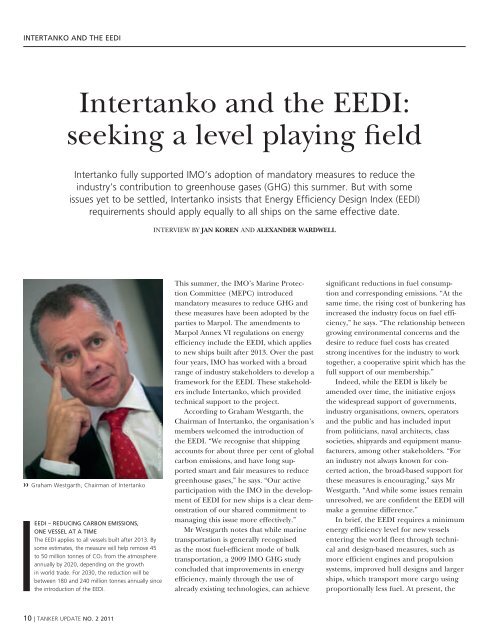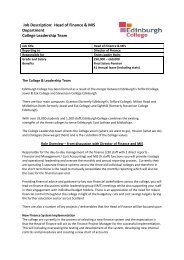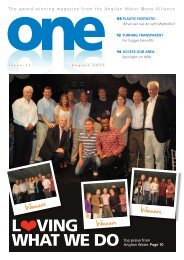update NewS from dNv to the tANker INduStry No 02 2011 - Hays
update NewS from dNv to the tANker INduStry No 02 2011 - Hays
update NewS from dNv to the tANker INduStry No 02 2011 - Hays
You also want an ePaper? Increase the reach of your titles
YUMPU automatically turns print PDFs into web optimized ePapers that Google loves.
Intertanko and <strong>the</strong> EEDIIntertanko and <strong>the</strong> EEDI:seeking a level playing fieldIntertanko fully supported IMO’s adoption of manda<strong>to</strong>ry measures <strong>to</strong> reduce <strong>the</strong>industry’s contribution <strong>to</strong> greenhouse gases (GHG) this summer. But with someissues yet <strong>to</strong> be settled, Intertanko insists that Energy Efficiency Design Index (EEDI)requirements should apply equally <strong>to</strong> all ships on <strong>the</strong> same effective date.Interview by Jan Koren and Alexander Wardwell›› Graham Westgarth, Chairman of IntertankoEEDI – reducing carbon emissions,one vessel at a timeThe EEDI applies <strong>to</strong> all vessels built after 2013. Bysome estimates, <strong>the</strong> measure will help remove 45<strong>to</strong> 50 million <strong>to</strong>nnes of CO2 <strong>from</strong> <strong>the</strong> atmosphereannually by 2<strong>02</strong>0, depending on <strong>the</strong> growthin world trade. For 2030, <strong>the</strong> reduction will bebetween 180 and 240 million <strong>to</strong>nnes annually since<strong>the</strong> introduction of <strong>the</strong> EEDI.Pho<strong>to</strong>: DNV/Nina E. RangøyThis summer, <strong>the</strong> IMO’s Marine ProtectionCommittee (MEPC) introducedmanda<strong>to</strong>ry measures <strong>to</strong> reduce GHG and<strong>the</strong>se measures have been adopted by <strong>the</strong>parties <strong>to</strong> Marpol. The amendments <strong>to</strong>Marpol Annex VI regulations on energyefficiency include <strong>the</strong> EEDI, which applies<strong>to</strong> new ships built after 2013. Over <strong>the</strong> pastfour years, IMO has worked with a broadrange of industry stakeholders <strong>to</strong> develop aframework for <strong>the</strong> EEDI. These stakeholdersinclude Intertanko, which providedtechnical support <strong>to</strong> <strong>the</strong> project.According <strong>to</strong> Graham Westgarth, <strong>the</strong>Chairman of Intertanko, <strong>the</strong> organisation’smembers welcomed <strong>the</strong> introduction of<strong>the</strong> EEDI. “We recognise that shippingaccounts for about three per cent of globalcarbon emissions, and have long supportedsmart and fair measures <strong>to</strong> reducegreenhouse gases,” he says. “Our activeparticipation with <strong>the</strong> IMO in <strong>the</strong> developmen<strong>to</strong>f EEDI for new ships is a clear demonstrationof our shared commitment <strong>to</strong>managing this issue more effectively.”Mr Westgarth notes that while marinetransportation is generally recognisedas <strong>the</strong> most fuel-efficient mode of bulktransportation, a 2009 IMO GHG studyconcluded that improvements in energyefficiency, mainly through <strong>the</strong> use ofalready existing technologies, can achievesignificant reductions in fuel consumptionand corresponding emissions. “At <strong>the</strong>same time, <strong>the</strong> rising cost of bunkering hasincreased <strong>the</strong> industry focus on fuel efficiency,”he says. “The relationship betweengrowing environmental concerns and <strong>the</strong>desire <strong>to</strong> reduce fuel costs has createdstrong incentives for <strong>the</strong> industry <strong>to</strong> work<strong>to</strong>ge<strong>the</strong>r, a cooperative spirit which has <strong>the</strong>full support of our membership.”Indeed, while <strong>the</strong> EEDI is likely beamended over time, <strong>the</strong> initiative enjoys<strong>the</strong> widespread support of governments,industry organisations, owners, opera<strong>to</strong>rsand <strong>the</strong> public and has included input<strong>from</strong> politicians, naval architects, classsocieties, shipyards and equipment manufacturers,among o<strong>the</strong>r stakeholders. “Foran industry not always known for concertedaction, <strong>the</strong> broad-based support for<strong>the</strong>se measures is encouraging,” says MrWestgarth. “And while some issues remainunresolved, we are confident <strong>the</strong> EEDI willmake a genuine difference.”In brief, <strong>the</strong> EEDI requires a minimumenergy efficiency level for new vesselsentering <strong>the</strong> world fleet through technicaland design-based measures, such asmore efficient engines and propulsionsystems, improved hull designs and largerships, which transport more cargo usingproportionally less fuel. At present, <strong>the</strong>10 | Tanker UPDATE NO. 2 <strong>2011</strong>
















